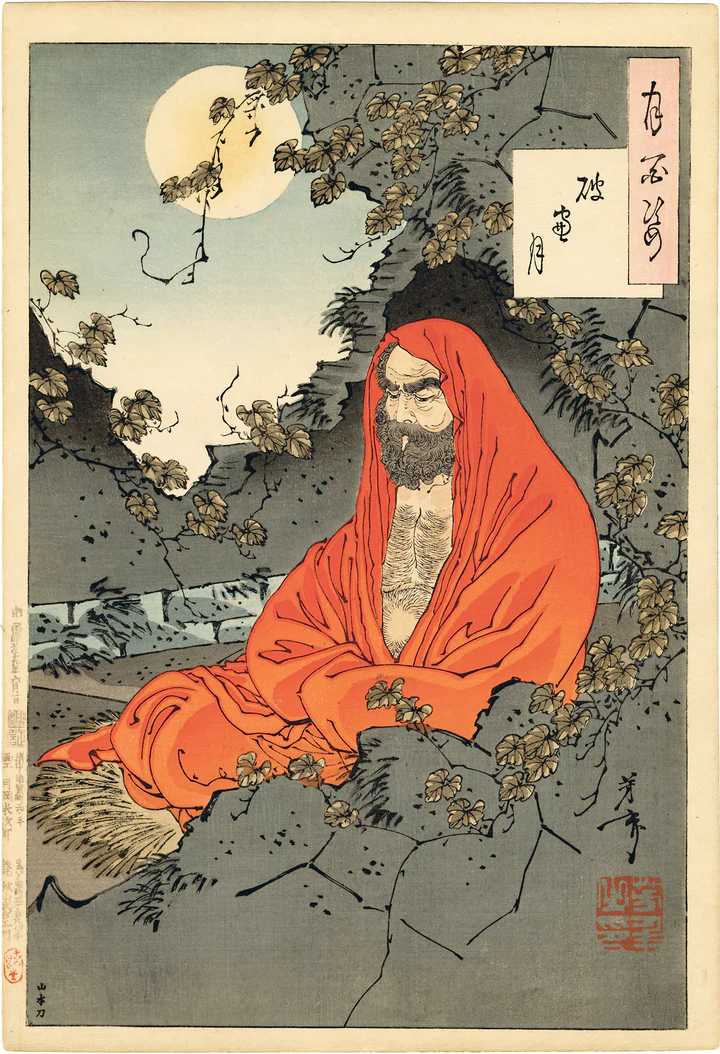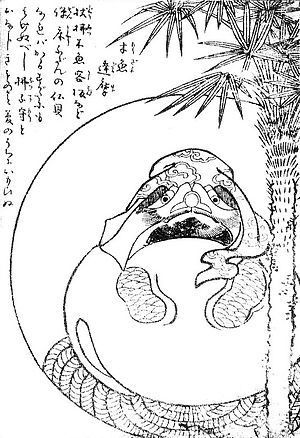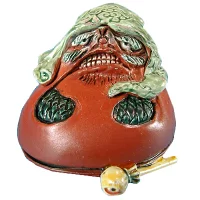


Japanese Yokai: Hino 2: Mokugyo Daruma
Wooden fish daruma:
ーJapanese Yokai in the Yokai Art Book “Hyakki Tsurezure Bukuro” by Sekien Toriyamaー
It is depicted as a mokugyo, with a bearded face, sitting on a circle.
Commentary by Sekien:
It is explained that it is a kind of Hoskomori, which is a specter of Buddhist altar fittings like mokugyo.
Mokugyo originally kept its eyes open day and night.
It was made to preach to monks to practice sleepless and restless training.
Daruma Daishi is said to have practiced for nine years without sleeping.
-Yokai created by Sekien as an association of things that never sleep-
Ukiyo-e artist Yoshitoshi Tsukioka produced a nishiki-e “Hyakuki Yagyō” (1865)
He painted a picture that seems to be based on Sekien’s Mokugyo Daruma.
https://ja.wikipedia.org/wiki/%E6%9C%A8%E9%AD%9A%E9%81%94%E7%A3%A8
Yokai japonais : Hino 2 : Mokugyo Daruma
Daruma poisson en bois :
ー Yokai japonais dans le livre d’art Yokai “Hyakki Tsurezure Bukuro” par Sekien Toriyama ー
Il est représenté comme un mokugyo, au visage barbu, assis en cercle.
Commentaire de Sekien :
Il est expliqué qu’il s’agit d’une sorte de Hoskomori, qui est un spectre des aménagements d’autels bouddhiques comme le mokugyo.
Mokugyo gardait à l’origine les yeux ouverts jour et nuit.
Il a été fait pour prêcher aux moines de pratiquer un entraînement sans sommeil et sans repos.
Daruma Daishi aurait pratiqué pendant neuf ans sans dormir.
-Yokai créé par Sekien comme une association de choses qui ne dorment jamais-
L’artiste Ukiyo-e Yoshitoshi Tsukioka a produit un nishiki-e “Hyakuki Yagyō” (1865)
Il a peint une image qui semble être basée sur Mokugyo Daruma de Sekien.
Japanisches Yokai: Hino 2: Mokugyo Daruma
Fisch-Daruma aus Holz:
ーJapanischer Yokai im Yokai-Kunstbuch „Hyakki Tsurezure Bukuro“ von Sekien Toriyamaー
Es wird als Mokugyo dargestellt, mit einem bärtigen Gesicht, das auf einem Kreis sitzt.
Kommentar von Sekien:
Es wird erklärt, dass es sich um eine Art Hoskomori handelt, was ein Gespenst buddhistischer Altarausstattung wie Mokugyo ist.
Mokugyo hielt ursprünglich Tag und Nacht die Augen offen.
Es wurde gemacht, um den Mönchen zu predigen, schlafloses und unruhiges Training zu praktizieren.
Daruma Daishi soll neun Jahre lang ohne Schlaf praktiziert haben.
-Yokai wurde von Sekien als eine Vereinigung von Dingen geschaffen, die niemals schlafen-
Der Ukiyo-e-Künstler Yoshitoshi Tsukioka produzierte ein Nishiki-e “Hyakuki Yagyō” (1865)
Er malte ein Bild, das auf Sekiens Mokugyo Daruma zu basieren scheint.